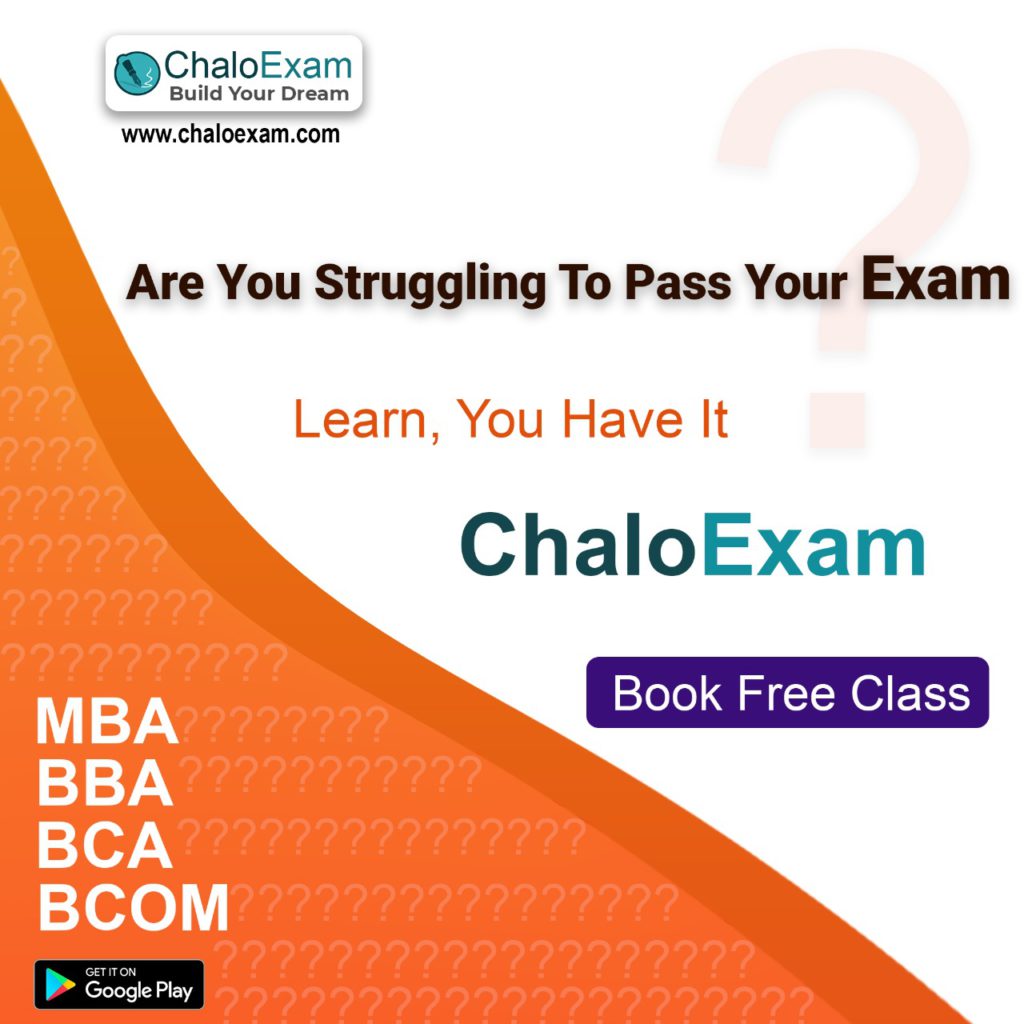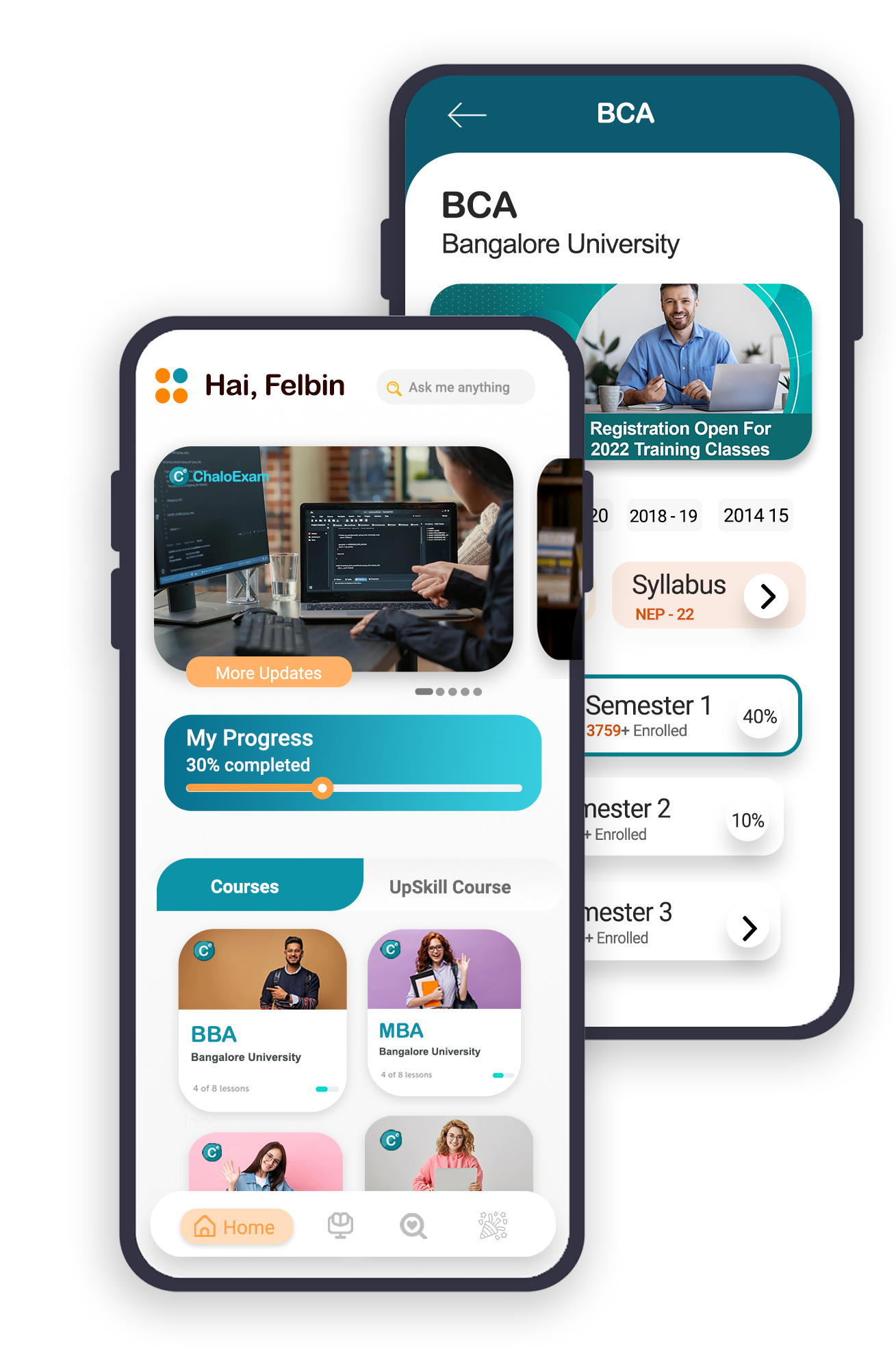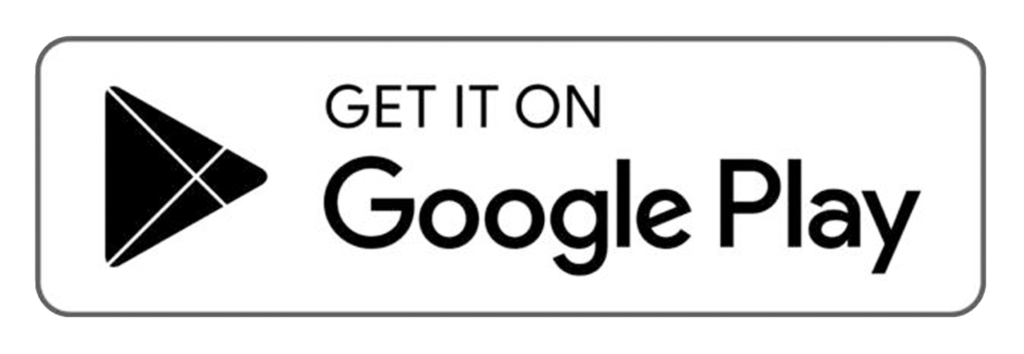Book Free Classes
Bangalore University 1st Sem BCA Study Materials
Download free BCA 1st sem module wise notes, latest solved question papers, previous 5 years question paper till 2021, model question papers, easy notes, exam oriented notes are available on this website chaloexam.com of Bangalore University
Problem Solving Techniques using C

Problem Solving Techniques using C
Problem Solving Techniques using C
Digital Electronics

Digital Electronics
Digital Electronics
Discrete Mathematics

Discrete Mathematics
Discrete Mathematics
Bangalore University and Bangalore North University BCA syllabus 2020
Syllabus
Syllabus
FIRST SEMESTER BCA
BCA101T : INDIAN LANGUAGE
Syllabus as per the one prescribed for science courses of Bangalore University.
BCA102T : ENGLISH
Syllabus as per the one prescribed for science courses of Bangalore University.
BCA103T : PROBLEM SOLVING TECHNIQUES USING C
Total Teaching Hours : 60 No of Hours / Week : 04 Unit - I
Introduction to Programming Concepts: Software, Classification of Software, Modular Programming, Structured Programming, Algorithms and Flowcharts with examples. Overview of C Language: History of C, Character set, C tokens, Identifiers, Keywords, Data types, Variables, Constants, Symbolic Constants , Operators in C, Hierarchy of Operators, Expressions, Type Conversions and Library Functions.
[12 Hours ]
Unit - II
Managing Input and Output Operation: Formatted and Unformatted I/O Functions, Decision making, branching and looping: Decision Making Statements - if Statement, if– else statement, nesting of if-else statements, else–if ladder, switch statement,?: operator, Looping - while, do-while, for loop, Nested loop, break, continue, and goto statements. Functions: Function Definition, prototyping, types of functions, passing arguments to functions, Nested Functions, Recursive functions.
[12 Hours ]
Unit - III
Arrays: Declaring and Initializing, One Dimensional Arrays, Two Dimensional Arrays, Multi Dimensional Arrays - Passing arrays to functions. Strings: Declaring and Initializing strings, Operations on strings, Arrays of strings, passing strings to functions. Storage Classes - Automatic, External, Static and Register Variables.
[12 Hours ]
Unit-IV
Structures-Declaring and Initializing, Nested structure, Array of Structure, Passing Structures to functions, Unions, typedef, enum, Bit fields. Pointers – Declarations, Pointer arithmetic, Pointers and functions, Call by value, Call by reference, Pointers and Arrays, Arrays of Pointers, Pointers and Structures. Meaning of static and dynamic memory allocation, Memory allocation functions.
[ 12 Hours ] Unit-V
Files - File modes, File functions, and File operations, Text and Binary files, Command Line arguments. C Preprocessor directives, Macros – Definition, types of Macros, Creating and implementing user defined header files.
[ 12 Hours ]
TEXT BOOKS
E. Balaguruswamy, “Programming In ANSI C”, 4th edition, TMH Publications, 2007
Ashok N. Kamthane, “Programming with ANSI and Turbo C”, Pearson Education, 2006
REFERENCES BOOKS
Page 7 of 38
Ashok N. Kamthane et. al., “Computer Programming and IT”, Pearson Education, 2011
Mahapatra, “ Thinking In C ”, PHI Publications, 1998.
Yashwant Kanetkar, “Let Us C”, 13th Edition, PHP, 2013.
BCA104T: DIGITAL ELECTRONICS
Total Teaching Hours : 60 No of Hours / Week : 04 Unit - I
Introduction to network theorems and AC fundamentals: Ohm’s law: Statement, explanation. Kirchhoff’s law: Statement & explanation of KCL and KVL. Mesh/loop analysis (up to 2 loops) and node voltage method, Numerical problems. Delta/star and star/Delta transformation: No derivation for Interco version equations, introduction of network, port of network (one port network, two port network), unilateral network, bilateral network, linear network. Need for application of network theorems. (DC Circuits only). Superposition theorem: statement, (only with TWO voltage sources) steps to apply the theorem explanation by considering a simple resistive network and problems. Thevenin’s theorem: Statement, (Only with ONE voltage source) Steps to apply the theorem, explanation by considering a simple resistive networking and problems. Norton’s theorem: Statement, (Only with ONE voltage source) steps to apply the theorem, explanation by considering a simple resistive network and problems. Maximum power transfer theorem: Statement, explanation of theorem by considering a simple resisting network, expression for maximum power deliver (P L (max) =Vth2/4Rth) (no derivation), graph of Vs Pl, numerical problems and applications. Reciprocity theorem, Statement, explanation using resistive network with dc source and numerical problems. AC Fundamentals: Representation of ac sine wave, instantaneous value, peak value, peak to peak value, average value, r.m.s value cycle, time period, frequency. (No derivations, only mention the expressions) Representation of non sinusoidal waves.
[ 12 Hours ]
Unit - II
Semiconductor Devices: Introduction, atomic structure, energy level, energy band diagram in solids, classification of conductors, insulators and semiconductors. Semiconductor, properties, crystal structure of semiconductor, types – intrinsic and extrinsic semiconductor. Intrinsic semiconductor: Crystal structure (Ge& Si), thermal generated charges (electron and holes) carriers the effect temp on their motion. Extrinsic semiconductor: Doping, donor acceptor impurities, c-type, p-type semiconductor, majority and minority carriers, their currents, concept of immobile ions. Semiconductor devices : PN junction diode, formation of pn junction layer, potential barrier, energy level diagram of pn junction, Biasing of pn junction, behaviour of pn junction under forward and reverse biasing, break down in pn junction, avalanche and zener break down. Diode characteristics; V-I characteristic, forward and reverse bias, diode parameters, bulk resistance, knee voltage, static and dynamic resistance, PIV. Application of diode; As a rectifier, as logic gate, as a switch, etc. Rectifier, types, Half wave Full wave. Half wave rectifier: Circuit, working, wave forms and expression for ripple factor and efficiency (no derivation), advantages & disadvantages. Bridge wave rectifier: Circuit, working, wave forms and expressions for ripple factor and efficiently (no derivation), advantages & disadvantages. Logic families: Scale of integration, Digital IC’s, classifications, DTL, TTL, ECL, MOS, CMOS, Mention of features: speed of operation, power dissipation, propagation delay, fan-in, fan-out. [ 12 Hours ]
Page 8 of 38
Unit – III
Number Systems: Introduction to number systems – positional and non-positional, Base /Radix. Decimal number system-Definition, digits, radix/base, Binary number system – Bit Byte, Conversions: Binary to Decimal and Decimal to Binary. Octal number system Conversion from Octal to Decimal to Octal, Octal to Binary and binary to Octal. Hexadecimal number system –Conversion : Decimal to Hex, Hex to decimal, Hex to Binary, Binary to Hex, Octal to Hex, Hex to Octal, Binary, arithmetic –binary addition, subtraction, multiplication and division (only Integer part). 1’s and 2’s compliment: 2’s complement subtraction. Binary code: BCD numbers, 8421 code, 2421 code- examples and applications. Gray code –Conversions-Gray to binary and Binary to Gray, application of gray code (Mention only). Excess-3 code – self complimenting property and applications. Definition and nature of ASCII code. Introduction to error detection and correction code, parity check. Boolean algebra:-Laws and theorems. AND, OR, NOT Laws, Commutative law, associative law, distributive law, Duality theorem. Demorgan’s theorems-Statements, proof using truth tables; Simplification of Boolean expressions using Boolean laws. Definition of product term, sum term, minterm, maxterm, SOP, standard POS and Standard POS. Conversion of Boolean expression to Standard SOP and Standard POS forms. Karnaugh maps-Definition of Karnaugh map, K- map for 2, 3 and 4 variables. Conversion of truth tables into k-map grouping of cells, redundant groups and don’t care conditions Karnaugh map technique to solve 3 variable and 4 variable expressions. Simplification of 3 and 4 variable Boolean expression using K-maps (SOP only)
[ 12 Hours ]
Unit - IV
Logic Gates: AND Gate: Definition, symbol truth table, timing diagram, Pin diagram of IC 7408. OR Gate: Definition, symbol, truth table, timing diagram of IC 7432. NOT Gate: Definition symbol, truth table, timing diagram, Pin diagram of IC 7404. NAND Gate: Definition, symbol, truth table, Pin diagram of IC 7400, NOR Gate: Definition, symbol, truth table, timing diagram, Pin diagram of IC 7402. Exclusive OR Gate: Definition, symbol, truth table, timing diagram. Combinational logic circuits: Definition, applications. Half Adder: Symbol, Logic circuits using XOR and basic gates, Truth table, Full Adder: Symbol, Logic circuits using XOR and basic gates, Truth table, Half Subtractor: Symbol, Logic circuits using XOR and basic gates, Truth table. Full Subtractor: Symbol, Logic circuits using XOR and basic gates, Truth table. Adder – Subtractor; Logic circuit, Pin diagram IC 7483, IC 7486. Parallel Adder: 4 –bit parallel binary adder, BCD adder, IC 7483 NAND –NOR implementation of Adders.
[ 12 Hours ]
Unit - V
Sequential Circuits: Importance of clock in digital circuit and introduction to flip flop. Flip –flop-difference between latch and flip-flop. Qualitative study of level and edge triggering. RS latch /unlocked, symbol and truth table. RS flip-flop using NAND gate, symbol, truth table and timing diagram. D flip –flop – Symbol, truth table, Realization of JK flip –flop using NAND gates, working, and timing diagram. Race around condition, present and clear inputs, pin diagram of IC 74112. T flip flop-Logic symbol, JK flip flop as a T flip –flop truth table and timing diagram. Master slave flip flop; Logic circuit, truth table and timing diagram, advantage of M/S flip-flop, pin diagram of IC 7473 IC 7476. Registers: Definition, types of registers-Serial in serial out, serial in parallel out, Parallel in serial out, Parallel in parallel our shift register (Block diagram representation for each), truth table, timing diagram and speed comparison.
[ 12 Hours ]
Page 9 of 38
Text Books:
1) Thomas L.Floyd ,’’Digital Fundamentals”, Peason Education Inc, New Delhi, 2003
Reference Books:
1) Morris Mano, “Digital Design”, 5Th Edition, Prentice Hall, 2013
2) R.P.Jain, “Modern Digital Electronics”, 3rd Edition, Tata Mc Graw Hill, 2003. 3) Bignell and Donovan, “Digital Electronics”, 5th Edition, Thomson Publication, 2007.
BCA105T: DISCRETE MATHEMATICS
Total Teaching Hours: 65 No of Hours / Week: 05 Unit – I
Sets, Relations and Functions: Sets, Subsets, Equal Sets, Universal Sets, Finite and Infinite Sets, Operation on Sets, Union, Intersection and Complements of Sets, Cartesian Product, Cardinality of Set, De-mogan’s law, Simple Applications. Relations, Properties of Relations, Equivalence Relation, Function: Domain and Range, Onto, Into, One to One, one to many Functions, Composite and Inverse Functions. Mathematical Logic: Proposition and truth values, Logical Connectives and their truth tables, Converse, Inverse and Contrapositive, Tautology and Contradiction, Logical Equivalence – Standard Theorems, Switching Circuits.
[ 13 Hours ]
Unit - II
Matrices: Review of fundamentals: Definition of matrix, order, Types of matrices: zero, row, column, square, diagonal, scalar, unit, symmetric, skew-symmetric. Determinant: Value of determinant of order 2x2, 3x3, minors, cofactors, adjoint, inverse of a matrix. Solutions of linear equations: Cramers rule and matrix method involving two and three variables. Eigen values and Eigenvectors: Characteristic equation, characteristic roots, characteristic vectors (without any theorems) only 2x2 order. Cayley Hamilton theorem. (Only statement), verification of Cayley Hamilton theorem (only 2x2 matrices), using the same finding the powers of A (A4, A5, A-1, A-2), Inverse of a Matrix using Cayley Hamilton theorem.
[ 13 Hours ]
Unit - III
Logarithms: Definition of Logarithm, Indices leading to Logarithms and vice versa, Laws of Logarithms with proofs, Problems, Common Logarithm: Characteristic and Mantissa, Use of Logarithmic Tables, Problems. Permutation and Combination: Fundamental Principle of Counting, Factorial n, Permutations: Definition, Examples, Derivation of Formula nPr, Permutation when all the objects are not distinct, Problems, Combinations: Definition, examples, Proving nCr = nPr r!, nCr = nCn-r, nCr + nCr-1 = n+1Cr , Problems based on above formulae.
[ 13 Hours ]
Unit - IV
Groups: Binary operation, Define of group, properties (only statement), problems (both finite and infinite groups), subgroup, theorems (no proof), problems. Vectors: Definition of vector and scalar, vector addition, dot and cross product, projection of a vector on the other (no geometrical meaning), area of parallelogram, area of a triangle, scalar triple product, volume of parallelepiped, co planarity of three vectors, vector triple product.
[ 13 Hours ]
Page 10 of 38
Unit - V
Analytical Geometry in Two Dimensions: Coordinates, Distance formula, Section Formula, Area of the Triangle formula (no derivation), Locus of point. Straight Line: Slope of a line and angle between two lines, Various forms of equations of lines – Derivation and Problems. Equation of family of lines passing through the point of intersection of two lines, Distance of a point from line (only problems).
[ 13 Hours ]
Text Books
Grewal, B.S.Higher engineering Mathematings, 36th Edition
Reference Books
Satyrs S.S, Engineering Mathematics.
Peter V.O’Neil. Advanced Engineering Mathematics, 5th Edition.
BCA103P: C PROGRAMMING LAB
PART – A
1) Write a C Program to find the roots of the given quadratic equation using if-else if statement.
2) Write a menu driven C program using switch-case to find: (a) Sum of the digits of number (b) Factorial of N.
3) Write a C program to find cos (x) using series cos(x) = 1 – x2/2! + x4/4! - ………xn/n! ]
4) Write a Program to find whether a given number is prime number are not 5) Write a C program to arrange the given set of numbers in ascending and descending order.
6) Write a C program to find product of two N x M matrices.
7) Write a C program to calculate NCR= N!/ R! * (N-R)! Using function. 8) Write a C program to display Fibonacci series using recursive function. 9) Write a C program to concatenate two strings using pointers.
10) Write a C program to copy content of one file to another file.
PART – B
During practical examination the External and Internal examiners may prepare exam question paper related to theory syllabus apart from Part-A. (A minimum of 10 Programs has to be prepared).
Note :
a) The candidate has to write both the programs One from Part-A and other from Part-B and execute one program as of External examiner choice.
b) A minimum of 10 Programs has to be done in Part-B and has to be maintained in the Practical Record.
c) Scheme of Evaluation is as follows:
Writing two programs - 10 Marks
Execution of one program - 10 Marks
Formatting the Output - 05 Marks
Viva - 05 Marks
Record - 05 Marks
Total - 35 Marks
BCA104P: DIGITAL ELECTRONICS LAB
Study of Logic Gates–AND, OR, NOT, NAND, NOR XOR
(Using respective ICs)
Realization of AND, OR and NOT gates using Universal Gates.
Page 11 of 38
Design and Realization of Half Adder/Subtracted using NAND Gates. 4. Design and Realization of Full Adder using Logic Gates.
Design and Realization of 4 bit Adder/Subtractor using IC 7483. 6. Design and Realization of BCD Adder using IC 7483.
Realization of J-K flip flop using IC 7400 and 7410.
Realization of T and D flip flop using IC 7476.
Implementation of PIPO Shift Registers using flip flops. (IC 7476). 10. Design and implementation of odd and even parity checker Generator using IC 74180.
PART – B
During practical examination the External and Internal examiners may prepare exam question paper related to theory syllabus apart from Part-A. (A minimum of 10 Programs has to be prepared).
Note :
a) The candidate has to write both the programs One from Part-A and other from Part-B and execute one program as of External examiner choice.
b) A minimum of 10 Programs has to be done in Part-B and has to be maintained in the Practical Record.
c) Scheme of Evaluation is as follows:
Writing two programs - 10 Marks
Execution of one program - 10 Marks
Formatting the Output - 05 Marks
Viva - 05 Marks
Record - 05 Marks
Total - 35 Marks









